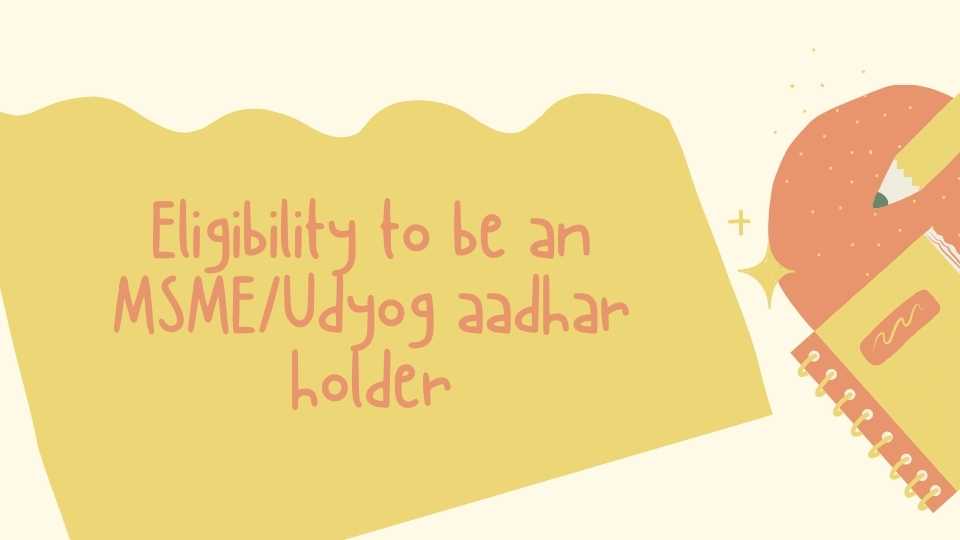Eligibility to be an MSME/Udyog Aadhar Holder

India’s MSME (Micro, Small, and Medium) enterprises made a significant contribution to the country’s economy during the 2017-18 fiscal year, with around 3.62 crore entities in operation. The MSME industry employs 55 million people and contributes about 8% of GDP. As a result, micro, small, and medium-sized enterprises (MSMEs) are an important part of India’s business sector.
The use of the Udyog Aadhar is required for MSME Registration / SSI Registration in India. In this essay, we’ll go over what a Udyog Aadhar application is, how to get one, and how it’s made it easier for MSMEs (Small Scale Industries) to register and get government incentives (SSI).
Eligibility for being an MSME
The Ministry of MSME specifies the rules for a Small Scale Industry (SSI) to qualify as an MSME in compliance with the MSME Development Act of 2006. The essential contrast between the three types of MSME enterprises, namely Micro, Small, and Medium Enterprises, is outlined below.
- Micro-manufacturing organizations with less than.25 lakh invested in plant and machinery, and microservice enterprises with less than.10 lakh invested in equipment, are the smallest entities.
- Small Enterprises: Small manufacturing organizations with plant and machinery investments ranging from 25 lakh to 5 crores, and small service businesses with equipment investments ranging from 10 lakh to 2 crores.
- Medium Enterprises: Small service organizations invest between 2 and 5 crores in equipment, while medium manufacturing firms invest between 5 and 10 crores in plants and apparatus.
The government of India has allowed several initiatives and is providing multiple benefits to MSMEs registered in India in order to promote the ease of doing business in India and the Make in India program. MSME registration under the guidelines of the Udyog Aadhar Memorandum (UAM) gives a slew of benefits, including MSME perks under GST and GST returns.
Udyog Aadhar
MSME’s Before Udyog Aadhar
In an effort to simplify and declutter the process of registering an MSME in India, the ministry introduced Udyog Aaadhar.
The former method of registering enterprises under the MSME legislation was time-consuming and demanding, including a great deal of paperwork and bureaucratic red tape. Prior to the current UAM system, the Entrepreneur Memorandum, or EM-I/II, was the older method of registering an MSME.
Udyog Aadhar: Introduction
Individual state governments will bear major responsibility for the development of MSMEs. After watching the lengthy procedures, delays, and difficulties in carrying out the activities. The Central Government decided to intervene and aid the state governments. The government achieved this by creating incentive programs and streamlining the registration process for nonprofits.
In September 2015, the Central Government, in collaboration with the Ministry of MSME, took a bold step by announcing that the current system of Entrepreneur Memorandum would be phased out (EM- I). Furthermore, the government pledged easier registration and greater MSME coverage in order for these enterprises to benefit from state/central government-led initiatives.
With the notification and recommendation of the VK Kamath committee, the provision of Udyog Aadhar was implemented in October 2015. What is Udyog Aadhar, exactly? You are welcome to inquire. Udyog Aadhar is a government registration that comes with a certificate of recognition and a unique number that certifies small/medium businesses and organizations.
The Udyog Aadhar was created with the primary purpose of providing the government with a streamlined way to support and enable the maximum amount of advantages to India’s small businesses.
Documents Required for Udyog Aadhar
The information and documents required to complete the registration process. And receive a Udyog Aadhar for your business are listed below.
- Name and Aadhar number of the company owner (as mentioned in the Aadhar card)
- For the social categories of SC, ST, and OBC, documentation is required as proof.
- Your company’s or organization’s name
- Information about your company’s previous registration
- What kind of company do you work for?
- Account information and current address
- National Industrial Classification Code, or NIC Code, is an abbreviation for National Industrial Classification Code.
- Your company’s total number of employees Your company’s current actions
- The entrepreneur’s email and cell phone numbers, as well as his or her PAN number and total investment in the business.





